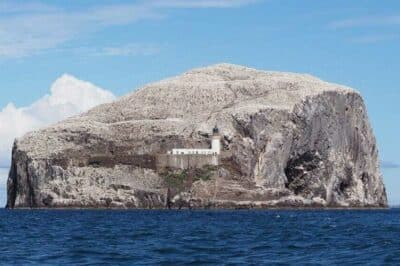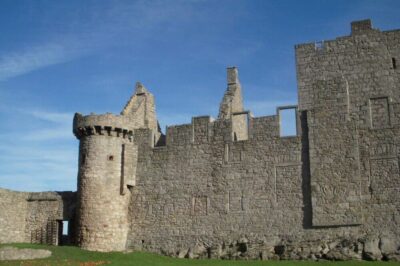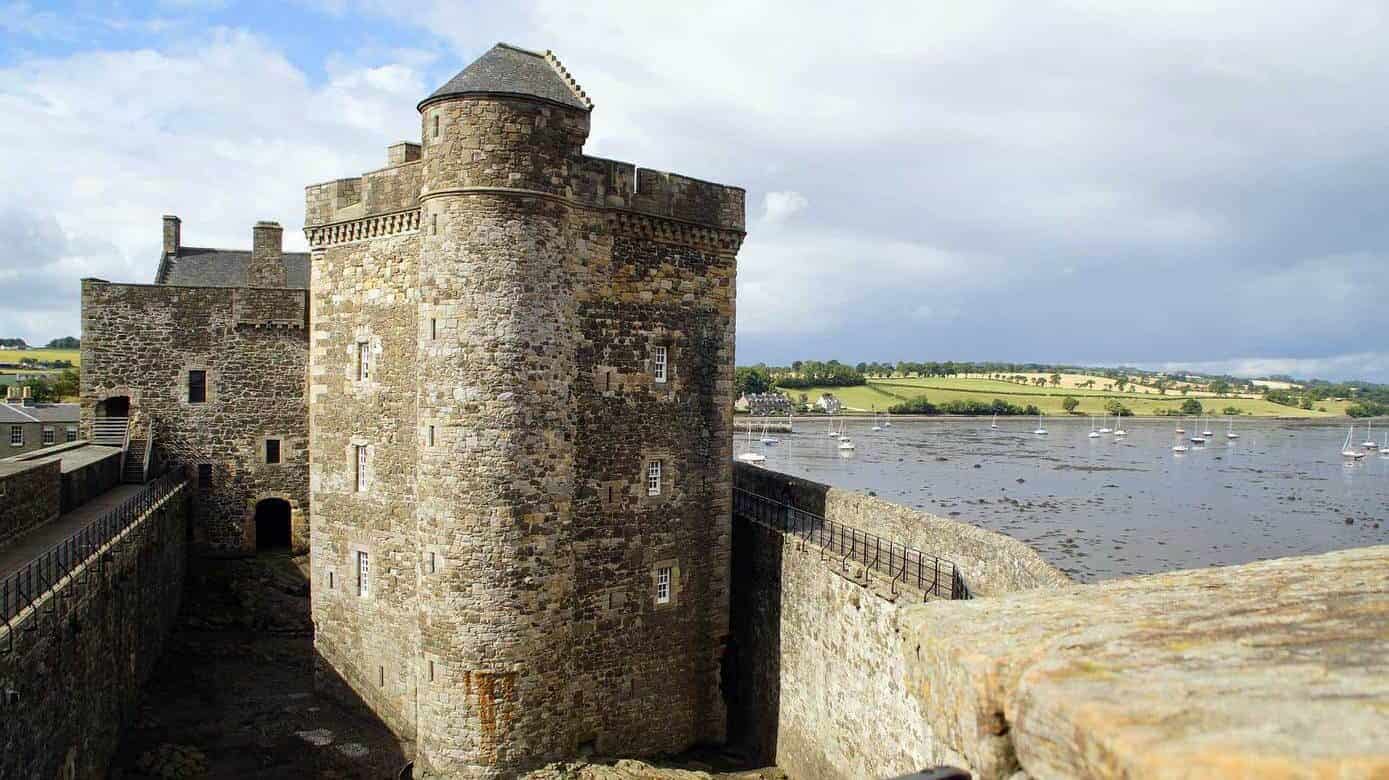
Blackness Castle, with its striking medieval architecture and scenic views of the Firth of Forth, has captured the imagination of many.
Among them are the creators of the popular TV series Outlander and the movie Mary Queen of Scots.
As a historic filming location, the castle serves as the perfect backdrop for dramatic storytelling, blending historical authenticity with cinematic flair. More about this below.
If you’re taking a day trip from Edinburgh, the castle is only around 5 miles from Linlithgow Palace, the birthplace of Mary Queen of Scots and 15 miles from Edinburgh Castle.
It’s reached by road through the village of Blackness or by the coastal path from Bo’ness.
The path, with impressive views over the Firth of Forth, and its three bridges, is part of the John Muir Way, a 134-mile route that runs from Helensburgh to John Muir’s birthplace in Dunbar.
The village served as the port for the royal burgh of Linlithgow during the 11th century.
Thanks to Its unusual boat shape, when seen from the seaward side it’s often referred to as the “ship that never sailed.” Its three towers add to the nautical effect.
Jo Woolf, at the time, Writer in Residence at the Royal Scottish Geographical Society, described it perfectly.
“…a glowering brute of a place, huge and forbidding. The occupants might have gone, but you can still feel their power.”
Jo Woolf
history of Blackness Castle
Over the centuries, the castle has been a state prison and military base for both British and French soldiers.
It was built in the 1440s, perhaps on the site of an earlier fort, by Sir George Crichton, Admiral of Scotland and a member of one of Scotland’s most influential and politically astute families.
In 1453, the fortress and surrounding lands were ‘acquired’ for the crown by James II. For much of the next century, it served mainly as a prison.
Henry VIII Rough Wooing
In the mid-16th century, Scotland faced a threat from Henry VIII over his attempts to force the Scots to agree to the marriage between his son Edward to Mary, Queen of Scots. It was a period that became known as the ‘Rough Wooing’.
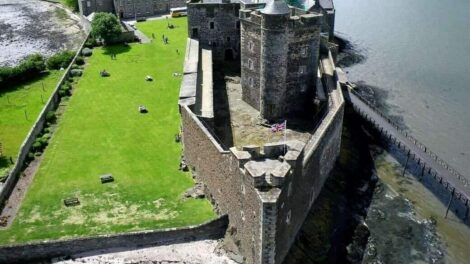
As part of the measures to counter that threat, James V appointed Sir James Hamilton of Finnart as Keeper of the castle. Hamilton began a major programme of refortification.
South-facing walls were strengthened to withstand cannon fire, with new gunports being added in the south tower and the east wall.
Hamilton also moved the entrance from the more vulnerable east wall to the west wall.
The new entrance was protected by a caponier – a covered ditch within the external wall that allowed defenders to fire along that ditch should the outer gate be breached.
The caponier is one of only a few surviving in Scotland.
Such was its new air of invincibility that Sir Ralph Sadler, English ambassador to Scotland, reportedly told Henry VIII that the castle was impregnable.
Hamilton was executed in 1540, for conspiracy to assassinate the king. His work was continued by others and completed three years later. Much of what remains today dates to this period.
regent to Mary Queen of Scots
In the same year that the reconstruction was completed, Cardinal David Beaton of St Andrews and regent to the infant Mary Queen of Scots. became one of the many prisoners incarcerated in this grim fortress.
During this time it was used as the main ammunition depot for a combined French and Scottish army.
In 1548, France’s Henry II agreed to further military support for Scotland. Both Dunbar and Blackness Castles were subsequently garrisoned by French soldiers.
In 1651, there was further work to strengthen the east curtain wall and the southern tower.
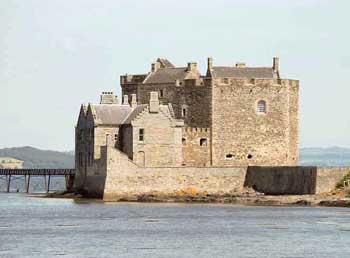
Despite this, the castle fell to General Monck, military commander of Oliver Cromwell’s forces, after a bombardment from land and sea.
Nearby, the remains of a small chapel dedicated to St Ninian are a forlorn sight.
The building was demolished by Monck’s gunners as they sought the best place for their gun batteries.
The castle was repaired following the Restoration of Charles II in 1660. Alterations were made to the central tower enabling it to hold Covenanter prisoners.
The nearby Bass Rock and Dunnottar Castle were also used to house Covenanters.
These were the ‘Killing Times’ when supporters of the National Covenant rose in opposition to the interference by Stuart kings in the Presbyterian church.
Act of Union 1707
Following the Act of Union in 1707, the castle was one of four to remain garrisoned by the British Army, in order to protect, Lowland Scotland from a Highland attack. The others were Dumbarton Edinburgh and Stirling.
In the same year, the castle turned from a state prison to a military base with new barracks and storage facilities constructed.
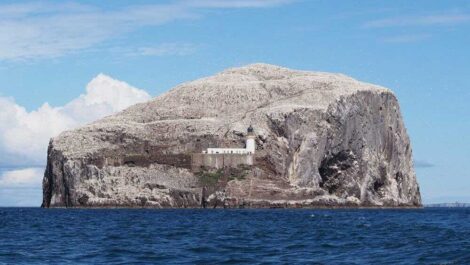
During the 18th and 19th centuries it was used to hold prisoners from Britain’s wars with America, France and Spain.
At the outbreak of World War I, the British Army moved in once again, remaining until 1919 when it reverted to state control.
In the following years yet more restoration was carried out.
During the work, an iron manacle was found in the notorious pit-prison still closed around the wrist of an unknown prisoner.
Blackness Castle: Mary, Queen of Scots
Blackness Castle doubled as the Palace of Holyroodhouse in the 2018 film Mary Queen of Scots starring Margot Robbie and Saoirse Ronan.
It also played its part in Ivanhoe, Macbeth and Hamlet.
Although, in real life, Mary may never have stayed at this formidable bastion, some family connections did visit.
Blackness Castle: Outlander film location
Like many of Scotland’s historic buildings, this imposing fortress, with its unique and atmospheric setting, has been featured as a filming location for multiple scenes in the TV series “Outlander” based on the book series by Diana Gabaldon.
Here are some notable appearances of Blackness Castle in “Outlander”:
Fort William:
This remarkable fortress was prominently used as the filming location for Fort William, a significant setting in the early seasons of the series.
Fort William is a fictional British garrison where Jamie Fraser, the protagonist, endures imprisonment and suffers at the hands of Black Jack Randall, a ruthless British officer.
Many scenes depicting the exterior and interior of Fort William were filmed within the walls capturing the dark and oppressive atmosphere of the story.
The Witch Trial:
One memorable scene takes place in the castle. In Season 1, Episode 11, Claire, the show’s lead character, faces a witch trial. The courtyard was utilised to portray this pivotal moment in the series.
Used as the venue where when Claire and Jamie met Bonnie Prince Charlie,
The Palace of Holyroodhouse in Edinburgh also played its part in the Outlander series.
Blackness Castle: visitor information
Blackness Castle is managed by Historic Environment Scotland (HES). As opening hours, ticket prices and accessibility information can sometimes change, please visit the official site by clicking the button below for the most up-to date information.
Related Content on Truly Edinburgh
For more information on Scotland’s visitor attractions and history, explore these related resources.
Suggestions for further reading & research
- Harkin, D., 2018. Blackness Castle. Building Surveying Journal, pp.34-35.
- Blackness, C.F., 2013. Geophysical Survey Report.
- Richardson, J.S., 1925, November. A Hoard of Bronze Objects from Wester Ord, Ross-shire, and an Early Iron Age Burial at Blackness Castle, Linlithgowshire. In Proceedings of the Society of Antiquaries of Scotland (Vol. 59, pp. 113-119).
- Taplin, P., 2018. Outlander’s Guide to Scotland. Batsford Books.
- Reid, S., 2012. Castles and Tower Houses of the Scottish Clans 1450–1650. Bloomsbury Publishing.
